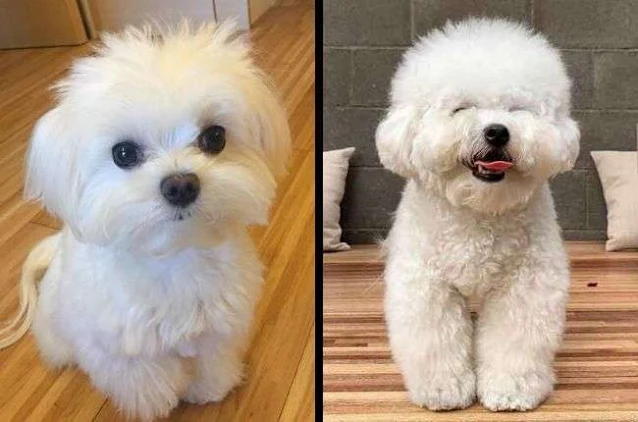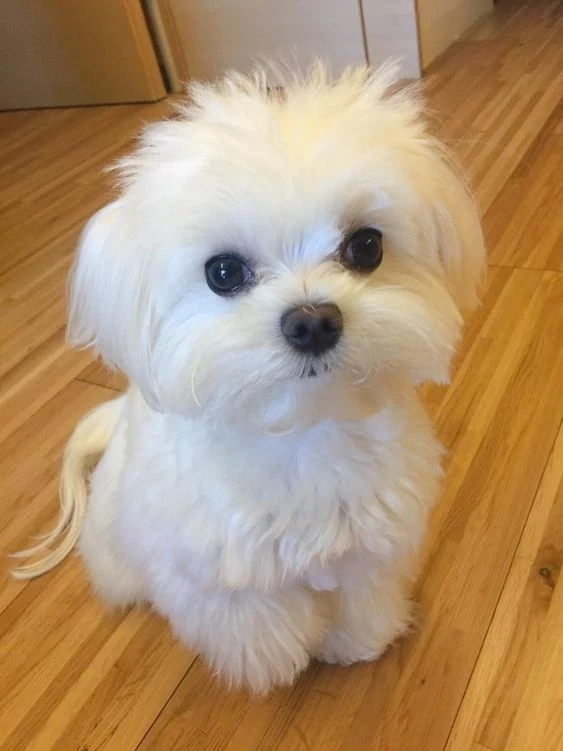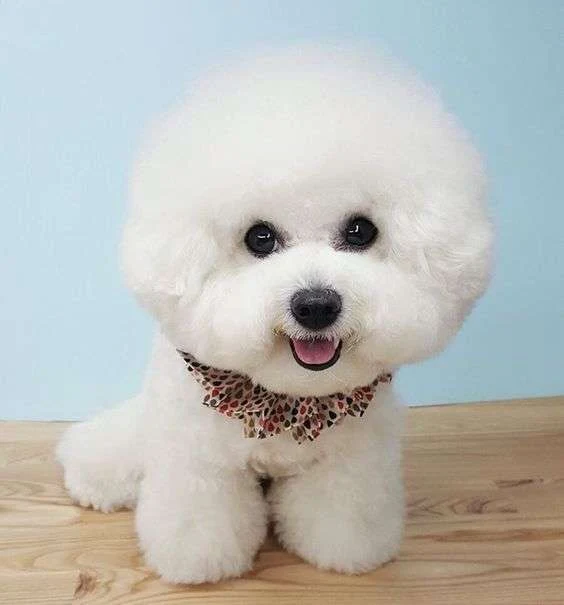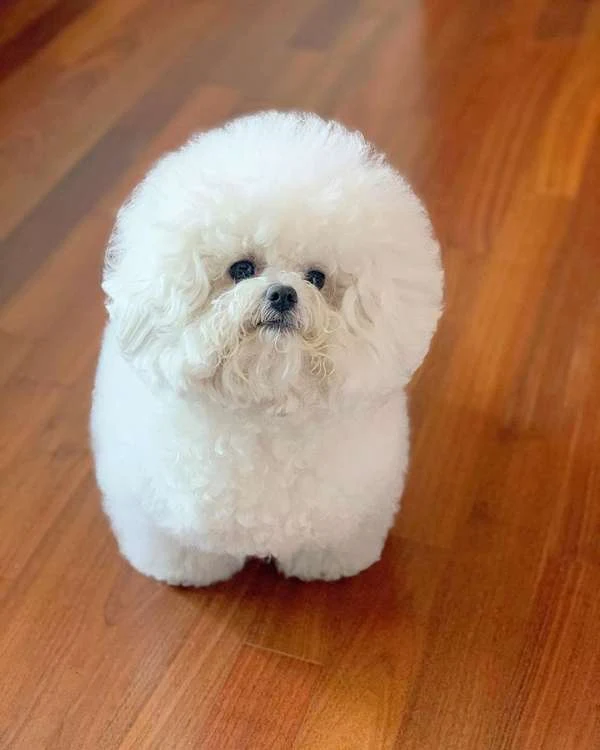However, there are also numerous physical and behavioral aspects by which both breeds are distinguished from each other and, therefore, here we review the main differences between Bichon Frise and Bichon Maltese.

ORIGIN
Although there are discrepancies as to the exact origin of the Maltese Bichon, most agree that it comes from the Mediterranean basin. Considered to be one of the oldest dog breeds in existence, the origin of this lapdog dates back to 6000 BC. The Romans took it to Asia, where it later gave rise to the Pekingese dog.
This canine family arose from the crossing of the extinct Barbet breed with the Mediterranean lapdogs, giving rise to two groups. On the one hand, the poodles, and on the other hand, the bichons.
In addition to those that occupy us today, also originated the Bichon Bolognese, the Bichon Havanese and Tenerife. The latter is the one that preceded today's Bichon Frise, which managed to save itself from extinction thanks to its great popularity in France and its export to the United States.
Both breeds are small in size and usually don't weigh more than 5 kilograms (12 pounds), but the Bichon Frise is generally slightly larger than the Maltese. While the Bichon Frise stands between 23 and 30 centimeters (9 and 12 inches) tall and weighs between 3 and 5 kilograms (6.6 and 11 pounds), the Maltese stands between 20 and 25 centimeters (8 and 10 inches) tall and weighs between 1.5 and 3 kilograms (3.3 and 6.6 pounds).
However, the biggest physical difference between the two breeds is undoubtedly the type of coat that distinguishes them at first glance. The Bichon Frise has a double-layered coat, with an undercoat and topcoat consisting of strong, dense and curly hair, similar to that of a poodle.
In general, the Frise variety wears its hair shorter, and although it can be left long, giving the dog a very fluffy appearance when brushed and trimmed, it does not reach the length of the Maltese coat.
The Maltese has a single, smooth, fine and straight coat, which is remarkable for its length, resembling that of a long-haired Yorkshire Terrier. As for the color of their coat, both are completely white, but sometimes the Maltese can have a slight yellowish or peach tinge in some areas.
Both breeds are affectionate and family-oriented dogs with great adaptability to their environment, situations, and people, but the Maltese is more adaptable to change than the Frise. Similarly, the Maltese has a stronger protective instinct, which can lead to jealousy and barking if not properly socialized.
In this sense, it is much easier to train the Bichon Frise than the Bichon Maltese, since the former is a sociable, playful, intelligent, obedient, and non-aggressive dog, in other words, the perfect pet for someone who has never had a dog.
With the latter, whose temperament is livelier, more vigilant and nervous, more perseverance, patience, and even a trainer may be necessary, depending on what you want to teach it, although no Bichon usually gives problems regarding their behavior, and they are excellent companions.
The main grooming requirement of Bichons is their hair, which makes them the ideal pet for allergy sufferers as they do not shed and are hypoallergenic. Both need frequent brushing and trimming to avoid tangles and to look good.
However, because of their distinct characteristics, each breed has some specific grooming needs. The curly coat of the Bichon Frise needs to be brushed daily with a stiff bristle brush to maintain the spongy hair.
It is ideal to bathe him once a month with a dry shampoo, and to avoid stains on his silky white hair, it is advisable to trim the hair around the ears and eyes.
As for the rest of the body, it is best to cut the hair with scissors, following the contours of the body.
The Bichon Maltese's hair is very soft, so it should be brushed gently every day with a comb to keep it smooth. It is necessary to pay special attention to the cleaning of the eyes and the beard so that the hair in these areas is not colored.
It is also a good idea to keep the hair on the head in a bun or ponytail so that it does not cover the eyes.
The Maltese coat is stunning but not as practical or comfortable to care for as it needs to be washed regularly with dry shampoo and dried properly. The ears must also be trimmed and well cleaned.
Both varieties of Bichon, the Bichon Maltese and the Bichon Frise, are typically hardy, long-lived and healthy breeds. However, they do have certain breed-specific conditions, particularly related to their eyes.
The Bichon Maltese can suffer from genetic eye diseases such as progressive retinal atrophy and ceroid lipofuscinosis, while the Bichon Frise can also have eye problems such as lacrimal duct atresia (blocked tear ducts) or cataracts (clouding of the natural lens of the eye).
In addition to eye problems, the Maltese can also suffer from patellar luxation (dislocated kneecap), distichiasis (extra eyelashes growing inward), hydrocephalus (water on the brain), and entropion (eyelids turning inward).
On the other hand, the Bichon Frise variety can suffer from patella dislocation and episodes of epilepsy (recurrent seizures).
This canine family arose from the crossing of the extinct Barbet breed with the Mediterranean lapdogs, giving rise to two groups. On the one hand, the poodles, and on the other hand, the bichons.
In addition to those that occupy us today, also originated the Bichon Bolognese, the Bichon Havanese and Tenerife. The latter is the one that preceded today's Bichon Frise, which managed to save itself from extinction thanks to its great popularity in France and its export to the United States.
 |
| Maltese |
Read also: Maltese, Bichon Frise, Havanese and Bolognese Comparaison
APPEARANCE AND PHYSICAL CHARACTERISTICS
 |
| Bichon Frise |
Both breeds are small in size and usually don't weigh more than 5 kilograms (12 pounds), but the Bichon Frise is generally slightly larger than the Maltese. While the Bichon Frise stands between 23 and 30 centimeters (9 and 12 inches) tall and weighs between 3 and 5 kilograms (6.6 and 11 pounds), the Maltese stands between 20 and 25 centimeters (8 and 10 inches) tall and weighs between 1.5 and 3 kilograms (3.3 and 6.6 pounds).
However, the biggest physical difference between the two breeds is undoubtedly the type of coat that distinguishes them at first glance. The Bichon Frise has a double-layered coat, with an undercoat and topcoat consisting of strong, dense and curly hair, similar to that of a poodle.
In general, the Frise variety wears its hair shorter, and although it can be left long, giving the dog a very fluffy appearance when brushed and trimmed, it does not reach the length of the Maltese coat.
The Maltese has a single, smooth, fine and straight coat, which is remarkable for its length, resembling that of a long-haired Yorkshire Terrier. As for the color of their coat, both are completely white, but sometimes the Maltese can have a slight yellowish or peach tinge in some areas.
CHARACTER AND BEHAVIOR
Both breeds are affectionate and family-oriented dogs with great adaptability to their environment, situations, and people, but the Maltese is more adaptable to change than the Frise. Similarly, the Maltese has a stronger protective instinct, which can lead to jealousy and barking if not properly socialized.
In this sense, it is much easier to train the Bichon Frise than the Bichon Maltese, since the former is a sociable, playful, intelligent, obedient, and non-aggressive dog, in other words, the perfect pet for someone who has never had a dog.
With the latter, whose temperament is livelier, more vigilant and nervous, more perseverance, patience, and even a trainer may be necessary, depending on what you want to teach it, although no Bichon usually gives problems regarding their behavior, and they are excellent companions.
EXERCISE AND NUTRITION
 | |
| Bichon Frise |
As small dogs, neither Bichon needs a lot of exercise. In fact, since they are such active, nervous, and playful dogs, they do not need any additional training.
However, both the Bichon Frise and the Maltese love to walk and play outside, so it is recommended to spend more time outside with these pets than just the strictly necessary walks.
As far as food is concerned, the Bichon Frise does not need a special diet, but in the case of the Bichon Maltese, attention should be paid to crunchy foods to prevent dental problems, and overfeeding should be avoided.
CLEANLINESS AND SPECIAL CARE
The main grooming requirement of Bichons is their hair, which makes them the ideal pet for allergy sufferers as they do not shed and are hypoallergenic. Both need frequent brushing and trimming to avoid tangles and to look good.
However, because of their distinct characteristics, each breed has some specific grooming needs. The curly coat of the Bichon Frise needs to be brushed daily with a stiff bristle brush to maintain the spongy hair.
It is ideal to bathe him once a month with a dry shampoo, and to avoid stains on his silky white hair, it is advisable to trim the hair around the ears and eyes.
As for the rest of the body, it is best to cut the hair with scissors, following the contours of the body.
The Bichon Maltese's hair is very soft, so it should be brushed gently every day with a comb to keep it smooth. It is necessary to pay special attention to the cleaning of the eyes and the beard so that the hair in these areas is not colored.
It is also a good idea to keep the hair on the head in a bun or ponytail so that it does not cover the eyes.
The Maltese coat is stunning but not as practical or comfortable to care for as it needs to be washed regularly with dry shampoo and dried properly. The ears must also be trimmed and well cleaned.
 |
| Maltese |
HEALTH
Both varieties of Bichon, the Bichon Maltese and the Bichon Frise, are typically hardy, long-lived and healthy breeds. However, they do have certain breed-specific conditions, particularly related to their eyes.
The Bichon Maltese can suffer from genetic eye diseases such as progressive retinal atrophy and ceroid lipofuscinosis, while the Bichon Frise can also have eye problems such as lacrimal duct atresia (blocked tear ducts) or cataracts (clouding of the natural lens of the eye).
In addition to eye problems, the Maltese can also suffer from patellar luxation (dislocated kneecap), distichiasis (extra eyelashes growing inward), hydrocephalus (water on the brain), and entropion (eyelids turning inward).
On the other hand, the Bichon Frise variety can suffer from patella dislocation and episodes of epilepsy (recurrent seizures).
In summary, both the Bichon Frise and the Bichon Maltese are charming lapdogs with similar fluffy white coats. But beneath the surface, there are subtle differences in temperament, activity level, and grooming needs. Consider your lifestyle and preferences when choosing between these two adorable breeds.
